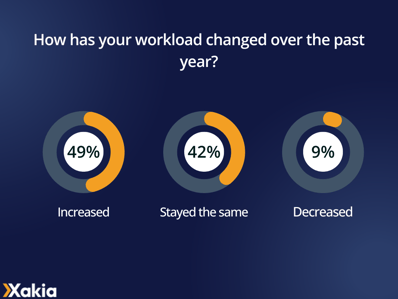Looking back on the industrial revolution, legend has it that automobile magnate Henry Ford once opined, “If I had asked people what they wanted, they would have said faster horses.”
In this century’s legal technology revolution, what do we want – and what do we need?
For in-house legal departments, the demand for “faster lawyers” is obvious: Nearly half – 49 percent – of in-house lawyers reported an increased workload over the past year in a recent ACC Global Census; 42 percent said the demand remained the same.
One primary driver is the ever-evolving regulatory landscape, which 70 percent of chief legal officers rank as a major stressor. (No wonder: 31 percent say they have been targeted by a regulator for a violation in the past two years.) The adoption of the General Data Protection Regulation (GDPR) alone had 47 percent of in-house counsel scurrying to change their company’s data security standards.
So today’s legal departments face a messy and mutating maze of regulations, unrelenting regulators and a bigger workload. As the work expands, three options emerge: Hire more lawyers, spend more on outside lawyers, or find new ways of doing things. In Henry Ford’s parlance, it’s time to either get faster horses or invent our own Model Ts.
Hoping for headcount is not a reliable solution; according to Altman Weil’s 2017 Chief Legal Officer Survey, for the 2018 calendar year:
- 51.6 percent planned to maintain their headcount of in-house lawyers;
- 76 percent planned to maintain their headcount of contract lawyers;
- 67.4 percent planned to maintain their headcount of paralegals; and
- 76.5 percent planned to maintain their headcount of support staff.
Nearly 10 percent planned to decrease their in-house lawyers.
So maybe outside help is on the way? Maybe not: In the same Chief Legal Officer survey, 28 percent planned to maintain their outside counsel spend, while 32.5 percent planned a decrease.
If we can’t grow the department, and we can’t increase the outside spend, one option remains: explore some new solutions. Enter in-house legal department software.

How do you start?
The LegalTech universe is already overwhelming: Stanford Law School’s Techindex tracks 855 companies serving the legal industry, to AI Patents, which automates patent analysis. It’s hard to know where to start – and harder still to ensure your technology initiatives work for your budget, your data security requirements, and most critically, your culture.
As advocates for both the LegalTech and in-house lawyer communities, we want to empower you to make the right technology choices. This means not exploring technology for technology’s sake, but knowing what you need (and what you don’t). This means performing an honest assessment of your department’s workload and capabilities, and ensuring you deliver on your organization’s strategy. And it means thinking in the long-term, so your technology works together and grows with you. Check out our blog on ensuring your legal technology matches your business needs.
Download the legal technology roadmap white paper to get started
The first step: Build a legal technology roadmap for your department. Our legal technology roadmap white paper will show you how to write a legal technology business case that doesn’t simply ask for “more lawyers,” but considers the processes and systems where technology can streamline delivery and increase accuracy. We have also included a template to get your legal technology roadmap started.
Once you have a plan in place, you can select and deploy your in house legal software. Over the next few weeks, we’ll share ideas and best practices for building a legal technology budget, getting your IT department on board and conquering the challenges inherent in legal technology implementation for in-house teams. We’ll look at technology as it applies to smaller teams and share benchmarking data from our Legal Operations Health Check. And we’ll consider how to answer the inevitable C-suite question, “What is the ROI for legal technology?”
Ready for a revolution? Let’s begin!
